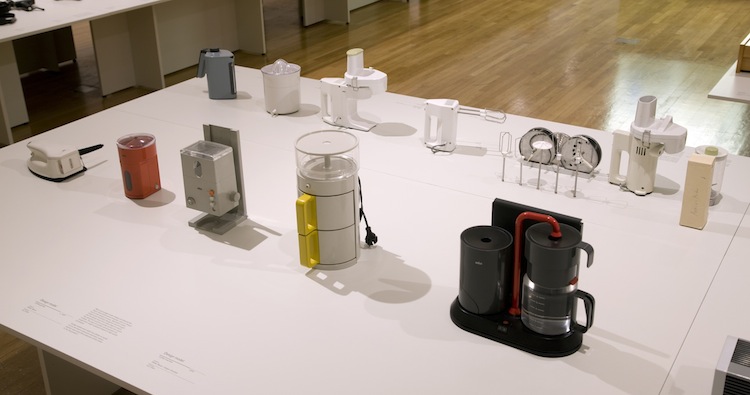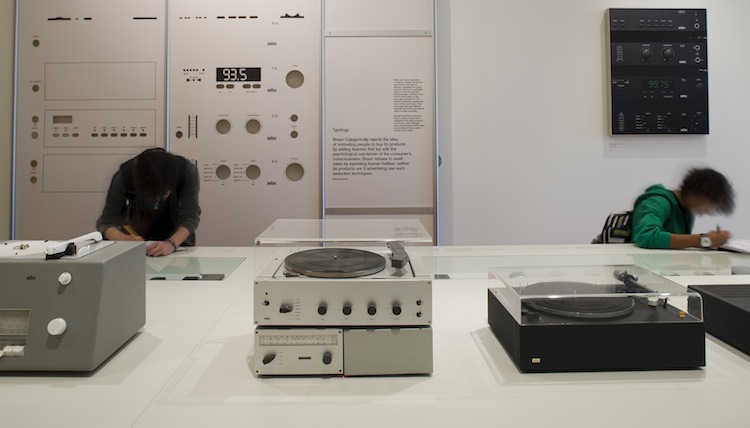Let's go back. It's as if there's a plot to drive consumers to create our own stockpile of printer ink. I know I have mine, or so it seems I do. But inevitably when I go to replace the single one that's run low, I have the wrong cartridges in my arsenal. Hell, I've got seven different colors in my printer, and each one has its own separate cartridge. So, I really need to be diligent when I run out of one and head to the store or order it online. Online seems like a great option, but when you order a single cartridge it can add up to $28, with $11 for shipping nearing half the total replacement cost.

Why can't our printers look good and function as simply as our household appliances? Dieter Rams' work at the Design Museum, photo by Luke Hayes
This led us to the next curiosity: How could my $100 printer have hundreds of dollars of printer ink in those little cartridges? When we build up our own stocks to avoid being caught empty, we can easily end up with $300-400 worth of ink on hand. Yet, the last time I prepared this way I got stung when I received a new printer free with a computer purchase. I then had to dispose of the old printer and an array of aging ink cartridges that nobody wanted.
Going into designer mode, I thought I'd investigate the problem further and discovered that this problem is serious -- really serious. According to a study in PC World, printer ink costs over $1000 a gallon -- at least that's what we pay for it -- and over half the ink is thrown away. To make the situation a little more painful, you can't recycle ink unless you're willing to refill cartridges yourself or work with a service, which seems reasonable enough if you're sufficiently upset about the situation to behave responsibly. Yet, the American Consumer Institute estimated that we overspend $6 billion a year on printer ink. And to top it off, by 2012, 1.8 billion cartridges will have been dumped into our landfills (and oceans). Each will take 450 to 1,000 years to decompose -- and that's after creating up to five kilograms of greenhouse gases to produce each cartridge.
There has to be a better way. As a society, we identify pain points and harness them to reflect on our needs and aspirations to create a better world with inspired innovation. Or we try to, right? Then it came to me. Why not take the modern 'Apple' approach to the ink model -- simple, intelligent, minimalist and user-friendly? Who here remembers that Apple used to make printers, and would like to see Apple help us yet again?

Would Apple's printer look something like this? Electronics at the Dieter Rams exhibition at the Design Museum, photo by Luke Hayes
I could see having an Apple printer next to me. It would look great, of course, that's always a must since I'm a visual person. But more importantly, it would have the intelligence I've come to expect from Apple. To start it would have this great iPod-like ink cartridge that plugs in and ejects like a CD, going in and out of my iMac. It would link to my computer and monitor, tracking the lifeblood of my printer, reporting usage and calculating remaining print pages. While calculating my usage, the system would monitor and ping me when the time is right, asking if a replacement cartridge can be sent through my iTunes account. I say sure, why not. But then to my surprise, when alerted that I've mostly used black and very little of the colors, it offers to send me my own mix that has a larger amount of black and smaller of color. I just love it when I get this kind of surprise; it always puts a smile on my face and keeps me coming back.
Three days later the cartridge appears on my doorstep along with my Netflix films. Simple enough. I eject my current cartridge, plug in the new one, place the old one in its return packing and box, and place it next to my outgoing movie. They are both picked up and I get a deposit credit back into my iTunes account a few days later for my recycling efforts. I'm happy, Apple does it again, and the world is a cleaner better place for all of us.
Ok, back to the real world. This is just a fantasy for now, but hopefully someone will soon realize the long-term value in 'servicing' our individual printing needs. Maybe it will be Apple. But I can't wait for the day it happens.
Top image: 'ReBraun' by Markus Wolf, part of the Bootleg Objects series featuring modified Dieter Rams products